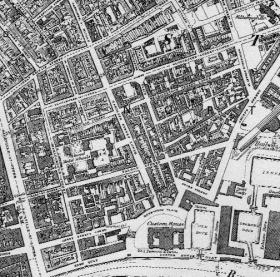‘Monto’
Published in 18th-19th Century Social Perspectives, 18th–19th - Century History, 20th Century Social Perspectives, 20th-century / Contemporary History, Features, Issue 3 (May/Jun 2008), Volume 16
The ‘Monto’ in 1876. (Ordnance Survey of Ireland)
As the nineteenth century progressed, prostitution in Dublin became more geographically confined. After the 1870s women began to move into cheaper accommodations available in the Lower Mecklenburgh Street area. The evidence of the Revd Robert Conlan to a commission on housing in 1885 revealed that brothels were extending into the district. He observed that some of the houses were regular bad houses, but that in the case of tenement houses ‘bad people who would carry on the same trade would take a flat’, so that brothels in this area were now to be found in tenement houses that also contained respectable families.
As early as 1837 this area was noted for its ‘great number of destitute poor, [and] dissolute and depraved characters’ of both sexes. The Mecklenburgh/Montgomery district of the city, north-east of the Custom House, marked the infamous ‘Monto’ district. By 1911 the renaming of streets in this area saw Waterford Street and Railway Street remaining notorious. While Tyrone Street was the most infamous street in the area, with a considerable number of brothels, the adjoining streets, Foley Street, Montgomery Street, Mabbot Street, Beaver Street, Purdon Street, Elliott Place, Faithful Place, Uxbridge and Nickleby, were almost as disreputable. In this area was located the famous ‘Becky Cooper’s’ (immortalised as Bella Cohen’s in the ‘Circe’ episode of Joyce’s Ulysses) and Mrs Mack’s, located at 85 Tyrone Street. Halliday Sutherland recalled that in 1904, as a medical student in Dublin, he had walked one evening down Tyrone Street. He observed that ‘in no other capital of Europe have I seen its equal. It was a street of Georgian houses and each one was a brothel. On the steps of every house women and girls dressed in everything from evening dress to a nightdress stood or sat.’
While it was to the ‘Monto’ area that prostitutes in Dublin had been gradually confined from the 1880s, this did not mean that prostitution did not exist or was less obvious in other parts of the city. Sackville Street (now O’Connell Street) was a principal promenading ground for prostitutes, and many were also to be found in the Phoenix Park, St Stephen’s Green and around the dock area. A police commissioner reported that prior to 1922 prostitution was mainly confined to a particular area stretching from Summerhill to Talbot Street and from Marlborough Street to the Five Lamps at the junction of Amiens Street and Portland Row.
















